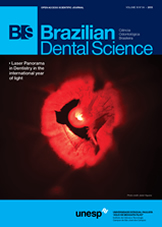Mechanical properties of the bond interface associated with nd:yag laser
DOI:
https://doi.org/10.14295/bds.2015.v18i4.1172Resumen
ABSTRACT
Objective:This study evaluated the hardness and modulus of elasticityof the dentin bond interface using total-etch (Single Bond /SB) and self-etch (Clearfil SE Bond/CSEB) adhesives associated with Nd:YAG Laser irradiation through the unpolymerized adhesives.Material and Methods: The occlusal surfaces of 12 human third molars were ground until superficial dentin was exposed. A standardized circular cavity was performed on the occlusal surface. Specimens were sectioned in the mesio-distal direction, and the 24 hemi-crowns were divided into four groups: Group SB/Control - SB + polymerization; Group SB/Laser - SB + Nd:YAG laser (174.16J/cm2/60s/non-contact) + polymerization; Group CSEB/Control – CSEB + polymerization; Group CSEB/Laser - CSEB + Nd:YAG laser (174.16J/cm2/cm2/60s/non-contact) + polymerization. Composite were placed in the cavities and polymerized. The specimens were immersed in distilled water and stored in an oven at 37ºC for 24h and then submitted to nanoindentation in a Nano Indenter® XP appliance. Results: The results were submitted to ANOVA, Tukey’s test and Student's-t test (p < 0.05). Conclusão: It was concluded that the application of the Nd:YAG laser in both adhesive systems did not changed the hybrid layer hardness; however, it increases the modulus of elasticity in the hybrid layer for both adhesives tested and it maybe preserves the integrity of the adhesive interface and its durability. Clinical relevance: The application of Nd:YAG laser prior to photopolymerization of adhesive systems can increase the modulus of elasticity in the hybrid layer and may contribute to stress distribution in the adhesive interface during the polymerization preserving the integrity of the adhesive interface and its durability.
Descargas
Descargas
Publicado
Cómo citar
Número
Sección
Licencia
Brazilian Dental Science uses the Creative Commons (CC-BY 4.0) license, thus preserving the integrity of articles in an open access environment. The journal allows the author to retain publishing rights without restrictions.
=================
COPYRIGHT TRANSFER AND RESPONSIBILITY STATEMENT
(PDF)
For all articles published in the BDS journal, copyright is retained by the authors. Articles are licensed under an open-access Creative Commons CC BY 4.0 license, meaning that anyone may download and read the paper for free. In addition, the article may be reused and quoted, provided that the original published version is cited. These conditions allow for maximum use and exposure of the work while ensuring that the authors receive proper credit. All metadata associated with published articles is released under the Creative Commons CC0 Universal Public Domain Dedication.
Before the submission, authors must obtain permission to reproduce any published material (figures, schemes, tables, or any extract of a text) that does not fall into the public domain or for which they do not hold the copyright. Permission should be requested by the authors from the copyright holder (usually the Publisher, please refer to the imprint of the individual publications to identify the copyright holder).
The authors hereby attest that the study is original and does not present manipulated data, fraud, or plagiarism. All names listed made a significant scientific contribution to the study, are aware of the presented data, and agree with the final version of the manuscript. They assume complete responsibility for the ethical aspects of the study.
This text must be printed and signed by all authors. The scanned version should be submitted as supplemental file during the submission process.




























